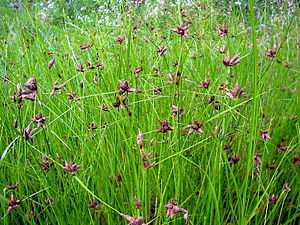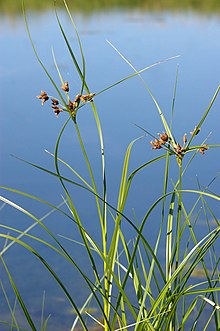Ordinary beach ledges
| Ordinary beach ledges | ||||||||||||
|---|---|---|---|---|---|---|---|---|---|---|---|---|

Common beach ledges ( Bolboschoenus maritimus ) |
||||||||||||
| Systematics | ||||||||||||
|
||||||||||||
| Scientific name | ||||||||||||
| Bolboschoenus maritimus | ||||||||||||
| (L.) Palla |
The common beach ledge ( Bolboschoenus maritimus ), also known as beach rush , is a plant species within the sourgrass family (Cyperaceae). It is a marsh plant with air-filled spaces in the underground organs ( helomorph ). Like many sedge and rush species, it used to be used as a wicker material .
description
Vegetative characteristics
The common beach ledge grows as a deciduous, perennial herbaceous plant and reaches heights of 30 to 120, sometimes up to 150 centimeters. Your "rhizome" is creeping. The runners are bulbously thickened at the tip. The stems grow rigidly upright to arched. They are leafy, sharp, triangular and very rough on top. The grass-like leaves are arranged in a spiral. The leaf sheaths of the upper leaves are green, the lower ones brown to black. The flat leaf blades are gradually narrowed into a long triangular tip. They reach 2 to 10 millimeters wide. The leaf margin and median nerve are rough above.
Generative characteristics
The flowering period extends from June to August, sometimes until October. Below the inflorescence arise two to three foliage-like bracts , which usually protrude far beyond the inflorescence. The inflorescence is a spiral and appears heady due to the shortened side branches. The reddish to blackish and ovate to elongated spikelets are sessile. They are between 9 and 20 millimeters long, multi-flowered and have one to ten per spiral branch. The husks are ovate, two-pointed and have an awn about 7 millimeters long in the bulge. Which consists of six to eight bristles perianth (Perianth) is longer than the fruit. The ovary is on top and has a three- grain style .
The fruit, an achenes , is about 3 millimeters long, obovate and has a short tip. The fruits of Bolboschoenus maritimus subsp. maritimus are triangular in cross section and medium to dark brown. The husks are also medium to dark brown. The achenes of Bolboschoenus maritimus subsp. paludosus , on the other hand, are curved outward on two sides (biconvex) and are medium brown. Its husks are dark brown to straw-colored or almost colorless. The outwardly curved (plano-convex) fruits of Bolboschoenus maritimus subsp. affinis are white to yellowish; the husks yellow-brown.
Chromosome number
The number of chromosomes is 2n = 104, less often 76, 77, 86, 110.
Occurrence
The common beach ledge is widespread worldwide in suitable locations in the subtropical and temperate areas. But it is missing in the Arctic . In Central Europe it occurs primarily in the coastal area at river and stream estuaries, on ditches in the mud flats, in wet dune hollows and on dikes; there they are found scattered and mostly stock-building. In the inland it occurs at salt pans. Otherwise it is quite rare in Central Europe.
It is limited to the lowlands up to an altitude of about 600 meters. It grows on flooded, mostly salty clay and silt soils on the coast . In the inland it settles on salt pans as well as on lake and river banks. It occurs partially in the silting areas of salt water and forms species-poor reeds . It is the characteristic of the plant society (association) of the beach ledge brackish water reed (Scirpetum maritimi Tx. 1937) from the Scirpion maritimi association.
The common ledge thrives best on base-rich muddy or silty soils , which can fall dry for a short time in summer, but which should otherwise be flooded. It also tolerates higher concentrations of table salt and moderate concentrations of nitrogen .
The common beach ledge is more widespread than previously thought in the reed beds of waters that are deeper than 500 meters, especially since it thrives well under the influence of fertilizers; because it does not depend on the occurrence of common salt in the soil, but is generally more competitive than other species with high ion concentrations.
Systematics
Synonyms for Bolboschoenus maritimus (L.) Palla are: Scirpus maritimus L. , Schoenoplectus maritimus (L.) Lye .
There are three subspecies:
- Bolboschoenus maritimus subsp. maritimus , (Syn .: Scirpus maritimus L. , Bolboschoenus maritimus subsp. compactus (Hoffm.) Hejný ): It occurs in the temperate zones of Eurasia and South Africa.
- Bolboschoenus maritimus subsp. affinis (Roth) T.Koyama (Syn .: Scirpus affinis Roth ): It occurs from southeastern European Russia to Indochina.
- Bolboschoenus maritimus subsp. paludosus (A.Nelson) T.Koyama (Syn .: Scirpus paludosus A. Nelson ): It occurs from North America to northern Argentina and Hawaii.
The subspecies differ in the color of the husks as well as in the shape and color of the fruit. The variety Bolboschoenus maritimus subsp. maritimus var. cymosus , which occurs in Europe to the Mediterranean . Further, Common forms the beach with the ledges eurasisch widely misunderstood beach bulrush ( Bolboschoenus Yagara ) the bastard beach ledges ( Bolboschoenus maritimus × Bolboschoenus Yagara ).
Sources and further information
literature
- J. Grau, B. Kremer, BM Möseler, G. Rambold & D. Triebel: Grasses. Mosaik Verlag, Munich 1990, ISBN 3-576-10702-9 Jürke Grau , Bruno P. Kremer, Bodo M. Möseler, Gerhard Rambold, Dagmar Triebel: Grasses. Sweet grasses, sour grasses, rushes and grass-like families in Europe (= Steinbach's natural guide ). New, edit. Special edition edition. Mosaik, Munich 1996, ISBN 3-576-10702-9 .
- Henning Haeupler, Thomas Muer: picture atlas of the fern and flowering plants of Germany . Ed .: Federal Agency for Nature Conservation (= The fern and flowering plants of Germany . Volume 2 ). Eugen Ulmer, Stuttgart (Hohenheim) 2000, ISBN 3-8001-3364-4 .
Individual evidence
- ↑ On the taxonomy, distribution and ecology of the Bolboschoenus group in Europe. (English; PDF online; 2.0 MB)
- ↑ a b Erich Oberdorfer : Plant-sociological excursion flora for Germany and neighboring areas . With the collaboration of Angelika Schwabe and Theo Müller. 8th, heavily revised and expanded edition. Eugen Ulmer, Stuttgart (Hohenheim) 2001, ISBN 3-8001-3131-5 , pp. 162 .
- ↑ a b c d e Rafaël Govaerts (Ed.): Bolboschoenus maritimus. In: World Checklist of Selected Plant Families (WCSP) - The Board of Trustees of the Royal Botanic Gardens, Kew . Retrieved October 28, 2016.
- ↑ a b c Dietmar Aichele, Heinz-Werner Schwegler: The flowering plants of Central Europe . 2nd Edition. tape 5 : Swan flowers to duckweed plants . Franckh-Kosmos, Stuttgart 2000, ISBN 3-440-08048-X .
Web links
- Ordinary beach ledges. In: FloraWeb.de.
- Ordinary beach ledges . In: BiolFlor, the database of biological-ecological characteristics of the flora of Germany.
- Profile and distribution map for Bavaria . In: Botanical Information Hub of Bavaria .
- Bolboschoenus maritimus (L.) Palla, map for distribution in Switzerland In: Info Flora , the national data and information center for Swiss flora .
- Map for worldwide distribution
- Thomas Meyer: Data sheet with identification key and photos at Flora-de: Flora von Deutschland (old name of the website: Flowers in Swabia )
- About beach ledges in Austria (English; PDF online)
- S. Galen Smith: Bolboschoenus. : The species Bolboschoenus maritimus , p. 40 with the subspecies B. maritimus subsp. maritimus and B. maritimus subsp. paludosus - the same text online as the printed work , In: Flora of North America Editorial Committee (Ed.): Flora of North America North of Mexico. Volume 23: Magnoliophyta: Commelinidae (in part): Cyperaceae , Oxford University Press, New York and Oxford, 2002. ISBN 0-19-515207-7
- The species with the subspecies B. maritimus subsp. affinis in the Flora of Pakistan .
- Bolboschoenus maritimus inthe IUCN Red List of Threatened Species 2013.2. Posted by: B. Kumar, D. Juffe Bignoli, RV Lansdown, 2010. Retrieved April 11, 2014.
- Data sheet with photos.
- Data sheet with photos.
- Data sheet with photos.


